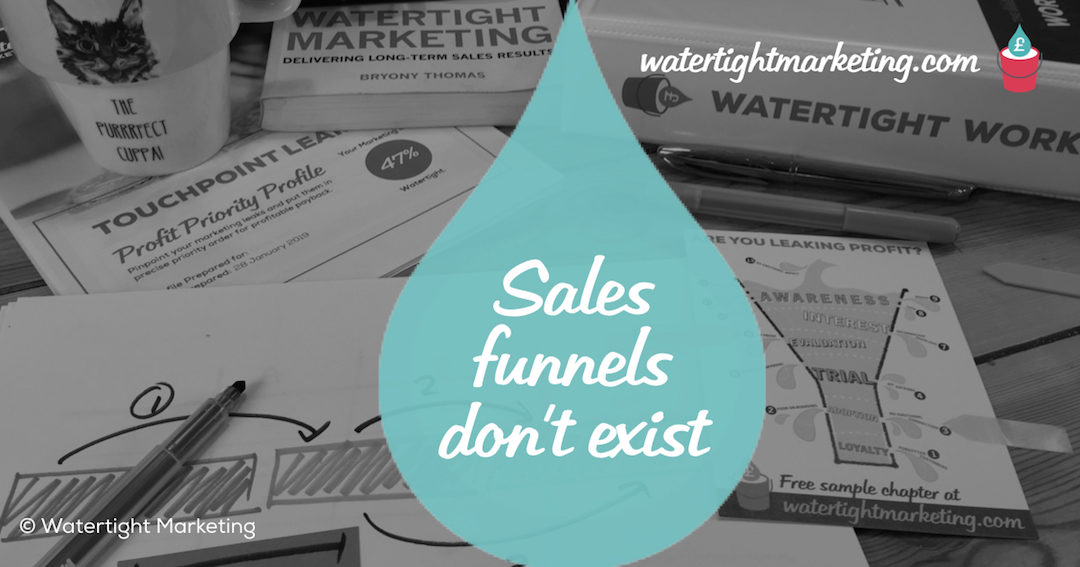Just because you can draw a neat funnel, does not mean that there is one!
I love a good sales funnel diagram. Call it a pipeline, a hopper, whatever. It’s helpful for organising your thoughts and mapping marketing tools and techniques to a buying decision.
But there’s a problem. It’s just not true.
I don’t know about you, but when I put water into the top of a funnel from my kitchen… it all comes out at the bottom. Wouldn’t it be wonderful if this were true in translation to your bottom line. Everyone who’d ever heard of your business would one day give you some money. Woohoo. Happy days!
But of course, it’s nowhere near a true reflection of the haphazard nature of, even the very best, sales and marketing operations. But it’s not just the inability to capture the reality that bugs me. There’s a real danger if the sales funnel gets too engrained as a mental image. It distorts your view of how things actually work. If you had to choose a kitchen utensil to depict many a ‘sales funnel’ I’ve encountered in the wild, it would probably be a collander. It’s funnel thinking that leads people into fruitlessly pouring money into the top, only to see it leaking through the gaping holes hiding there.
Accepting that marketing is, in fact, pretty messy is key to making it work for you. So, I’d like you to do something. I’d like you to delete the mental image you have of a sales funnel. Then, replace it with a Bucket, several Funnels and Taps.
What’s great about this new mental image is that it gets a lot closer to reality. It also helps you to see why marketing is most effective when approached the other way up. That is, bottom up… because there’s no point pouring money into a Bucket with a hole in it, and you’ll need some Funnels to catch and channel, and then (and only then) is it worth turning those expensive Taps on.
© Bryony Thomas – The Watertight Marketer | Illustrations by Lizzie Everard.

Bryony Thomas
Author & Founder, Watertight Marketing
Bryony Thomas is the creator of the multi-award winning Watertight Marketing methodology, captured in her best-selling book of the same name. She is one of the UK's foremost marketing thinkers, featured by the likes of Forbes, The Guardian, Business Insider and many more, and in-demand speaker for business conferences, in-house sales days and high-level Board strategy days.



Good point Bryony although I do like the funnel metaphor. Not perfect but it described it to the point where I “got” it and could then move on. Your new model is more accurate and yet less appealing.
Rob
Hi Rob, thanks for the feedback. I (partially) agree, I love the funnel mataphor. It’s very helpful as a shorthand and planning tool. Particularly if you see it as depicting a decreasing number of people through the process; therefore being funnel-shaped rather than behaving like an actual funnel.
Where the Bucket, Funnels & Taps idea has proven extremely powerful is in providing a language to sanity check marketing ideas. In a client context, where we’ve established and used this terminology, we can quickly categorise anything we’re planning as one of the three items, and think logically about whether we have something performing each function. This is easier to grasp, particularly for non-marketers, when you need to visualise the task rather than the stage of the process. I accept that it’s not as immediately appealing, but I have certainly found it to be a lot more useful in this context.
I believe the Funnel metaphor still has value for understanding and improving sales results.
I agree with the value of starting from the bottom and working up, understanding and appreciating customers, and growing business with them.
Also that businesses now have multiple funnels, each with outcomes that represent some people moving through their purchase process.
As multi-channel, multi-media and multi-touch becomes more prevalent there are real challenges for businesses to gain value for money from sales and marketing time and budgets.
I’m sure your new book and support systems will provide many valuable insights.
Thanks Mark. Agreed, it’s definitely useful in certain settings. Hey, I use it all the time! But, with caution.
As I said to Rob above, if people can see it as funnel-shaped rather than behaving like a funnel, it’s fine (although it would need to lie horizontally to represent the time factor). It’s when people mix this up with thinking it behaves like a funnel that’s unhelpful.